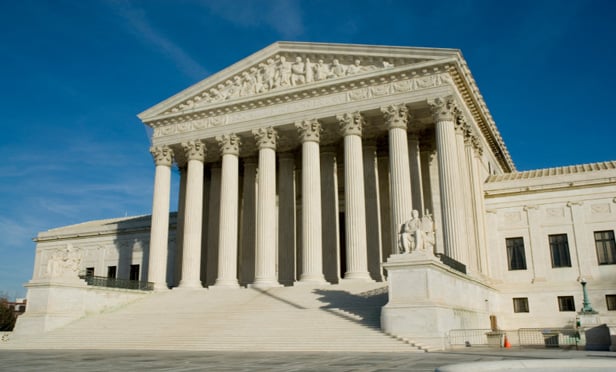Features

'Breaking News:' U.S. Supreme Court Buys Into Sports Betting in NJ and Beyond
The justices in <i>Murphy v. National Collegiate Athletic Association</i> found the 1992 Professional and Amateur Sports Protection Act infringed on state sovereignty. The decision could transform sports and sports gambling from coast to coast.
Features

Challenging Disproportionate Forfeitures
<b><i>Part One of a Two-Part Article</b></i><p>In <i>Honeycutt v. United States</i>, the Supreme Court rejected the argument that a federal criminal forfeiture statute permits joint and several liability for criminal asset forfeiture judgments, thereby protecting defendants who were only marginally culpable for a larger offense.
Features

SCOTUS Recap: What Lies Ahead for the Lower Courts' Tests for “Non-Statutory Insiders”
Ultimately, <i>Village at Lakeridge</i> is noteworthy for what the Supreme Court did not decide. In granting <i>certiorari</i>, the Supreme Court declined to address whether the lower courts' various “non-statutory insider” tests should be refined. As concurrences from Justices Sotomayor and Kennedy emphasized, though, that issue is ripe for increased scrutiny.
Features

Supreme Court Ties SEC's Hands in Whistleblower Case
With its decision in <i>Digital Realty v. Somers</i>, the U.S. Supreme Court dealt a blow to companies interested in learning of their own securities violations before the government gets the heads-up. The case's outcome means whistleblowers who might have reported violations internally will be incentivized to bypass their own companies' compliance mechanisms in favor of immediate reporting to the SEC.
Features

SCOTUS: No Safe Harbor Protection Where Financial Institutions are Mere Intermediaries
The Supreme Court's decision and analysis are instructive for both bankruptcy and corporate practitioners, and will likely yield significant returns for estate beneficiaries.
Features

Supreme Court Asked, Again, to Weigh In on Data Breach Standing as Circuit Split Widens
CareFirst, a large health care company involved in a data breach case, asked the U.S. Supreme Court to weigh in on whether victims can establish Article III standing to sue for the risk of future identity theft. The Court denied the request, leaving intact a recent district court holding that consumers could successfully plead such a claim issue — and leaving a split among the federal appellate courts.
Features

Will the Supreme Court Seismically Shift the Patent Damages Landscape in <i>WesternGeco v. ION</i>?
The U.S. Supreme Court recently agreed to consider whether a patentee may recover foreign lost profits resulting from infringement of a United States patent.
Features

The Profound Effect of TC Heartland on Patent Litigation
This article examines the impact of <i>TC Heartland</i> with a focus on recent Federal Circuit decisions applying <i>TC Heartland</i> and further clarifying the scope of where patent cases may be filed.
Features

Supreme Court Doesn't Sound Ready to Kill Off PTAB
<b><i>There Was No Clear Majority at Oral Argument Signaling the Death of</i> Inter Partes <i>Review</b></i><p>November 27 was supposed to be the big Patent Trial and Appeal Board (PTAB) showdown at the U.S. Supreme Court. After two hours of questioning, it seemed more like a big bust.
Features

Clarity for New York Takings Law
Determining whether or not a government regulation constitutes a “taking” for the purposes of the Fifth Amendment can be a complex endeavor. The recent Second Department decision of <i>Matter of New Creek Bluebelt, Phase 3 (Baycrest Manor Inc.)</i>, provides some guidance on three important regulatory takings issues.
Need Help?
- Prefer an IP authenticated environment? Request a transition or call 800-756-8993.
- Need other assistance? email Customer Service or call 1-877-256-2472.
MOST POPULAR STORIES
- Use of Deferred Prosecution Agreements In White Collar InvestigationsThis article discusses the practical and policy reasons for the use of DPAs and NPAs in white-collar criminal investigations, and considers the NDAA's new reporting provision and its relationship with other efforts to enhance transparency in DOJ decision-making.Read More ›
- The DOJ's New Parameters for Evaluating Corporate Compliance ProgramsThe parameters set forth in the DOJ's memorandum have implications not only for the government's evaluation of compliance programs in the context of criminal charging decisions, but also for how defense counsel structure their conference-room advocacy seeking declinations or lesser sanctions in both criminal and civil investigations.Read More ›
- The DOJ's Corporate Enforcement Policy: One Year LaterThe DOJ's Criminal Division issued three declinations since the issuance of the revised CEP a year ago. Review of these cases gives insight into DOJ's implementation of the new policy in practice.Read More ›
- Surveys in Patent Infringement Litigation: The Next FrontierMost experienced intellectual property attorneys understand the significant role surveys play in trademark infringement and other Lanham Act cases, but relatively few are likely to have considered the use of such research in patent infringement matters. That could soon change in light of the recent admission of a survey into evidence in <i>Applera Corporation, et al. v. MJ Research, Inc., et al.</i>, No. 3:98cv1201 (D. Conn. Aug. 26, 2005). The survey evidence, which showed that 96% of the defendant's customers used its products to perform a patented process, was admitted as evidence in support of a claim of inducement to infringe. The court admitted the survey into evidence over various objections by the defendant, who had argued that the inducement claim could not be proven without the survey.Read More ›
- Questions Every Law Firm Business Development Leader Should Be AskingIn a legal marketplace transformed by technology, heightened client expectations, and fierce competition, law firm leaders must approach strategy with rigor and clarity. The following questions, accompanied by relevant statistics and explanations, offer a focused guide for uncovering opportunity and driving sustainable growth.Read More ›
